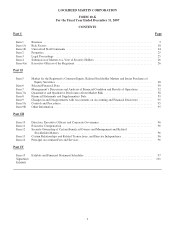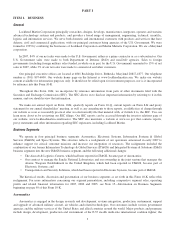Lockheed Martin 2007 Annual Report Download - page 20
Download and view the complete annual report
Please find page 20 of the 2007 Lockheed Martin annual report below. You can navigate through the pages in the report by either clicking on the pages listed below, or by using the keyword search tool below to find specific information within the annual report.
In 2007, IS&GS had net sales of $10.2 billion, which represented 24% of our total net sales. IS&GS’ three major lines
of business and the percentage that each contributed to its 2007 net sales are:
Mission Solutions
Information Systems
Global Services
46%
24% 30%
The segment is heavily dependent on both DoD and non-DoD agencies of the U.S. Government as customers. In 2007,
U.S. Government customers accounted for approximately 94% of the segment’s total net sales.
Mission Solutions
Mission Solutions combines our expertise with the requirements of Intelligence, Defense and Civil agency customers
with significant research and development and engineering competencies to provide solutions that produce an operational
effect or business outcome. Mission Solutions provides systems that gather, process, assimilate, fuse and distribute data from
ground, air, and space assets. We are also responsible for complex systems integration support that provides real-time
situational awareness information to the DoD. Key programs include a classified customer portfolio; transformational
communications systems such as the Transformational Communications MILSATCOM Mission Operations Segment
(TMOS) and the Warfighter Information Network-Tactical (WIN-T); mission and combat support solutions such as Global
Command Support System (GCSS) and the Combatant Commanders Integrated Command & Control Systems (CCICCS);
and mission critical civil agency programs including the U.S. Census, National Archives & Records Administration (NARA)
and Transportation Worker Identification Credential (TWIC).
In 2007, the TMOS program, which provides the network management system and operations management system for
the Government’s Transformational Communications MILSATCOM system, completed a successful system design review
with the U.S Air Force. We were also awarded the TWIC contract to support the enrollment and credential (card) issuance to
at least 750,000 transportation workers for the DHS. In October, our customer accepted the En Route Automation
Modernization (ERAM) system we developed and tested for the Federal Aviation Administration (FAA). Considered a
critical part of the National Airspace System’s future, ERAM is intended to be the backbone of the FAA’s en route
operations once it is fully operational. The system includes computer hardware, software and an extremely robust backup
capability with four levels of redundancy.
Information Systems
Information Systems provides functional expertise in business systems, IT infrastructure and process outsourcing,
systems based on the use of commercial technology, and solutions structured to deliver contractually specified levels of
service. The contracts within this line of business are mostly task order vehicles (indefinite-delivery/indefinite-quantity
(IDIQ) contracts) or Government Services Administration (GSA) schedules. Key programs include the FAA Automated
Flight Service Station (AFSS) and large IT infrastructure programs such as FBI Sentinel.
In June 2007, the FBI deployed the first phase of their next-generation information management system as a part of the
FBI Sentinel program, designed to provide FBI employees with a marked improvement in their ability to access, retrieve and
move information. Also in 2007, in support of the FAA AFSS program, our flight specialists began using our Flight Service
for the 21st Century (FS21) technology to provide flight services. FS21 streamlines flight planning and allows the sharing of
weather and air space system status across the entire AFSS network.
12
























